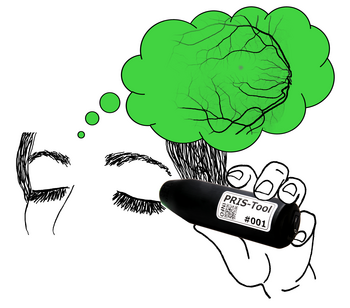PRIS-Tool
Purkinje Retinal Image Stabilizer - PRIS
Using light stimulation, our PRIS-Tool enables quick and easy perception of your own retinal vessels to check the function of the retina and to detect disease-related changes.
The PRIS-Tool contains green LEDs that light up in a certain way for light stimulation. To trigger the perception, the user closes their eyes and holds the PRIS tool on the side of one eyelid with light pressure. A shadow image of the own retinal vessels then appears in front of the “inner eye” as black, tree-like branching lines against a green background.
An assisting app is intended to support users in applying the PRIS-Tool with information and instructions, but also to help them reliably recognize and document retinal changes or abnormalities.
Clinical significance is seen, for example, as a simple additional diagnostic tool for the early detection of diabetic retinopathy worldwide and for the preoperative assessment of retinal function in cataract patients in low-income countries.
To confirm the reliability of the method, clinical studies are currently being prepared.
![[Translate to English:] logo_wm](/fileadmin/_processed_/b/1/csm_logo-wm_659a2829b5.png)
![[Translate to English:] BioCon_Valley](/fileadmin/_processed_/5/9/csm_BioCon_Valley_a633233e55.png)
Funding
The project "PRIS-Tool. Schnelles und einfaches Screening für die Augenheilkunde" is funded by the Ministry of Economics, Infrastructure, Tourism and Labor of Mecklenburg-Vorpommern as part of the Ideenwettbewerb Gesundheitswirtschaft Mecklenburg-Vorpommern 2024 "Innovative Ideen für die Gesundheitswirtschaft", supported by BioCon Valley GmbH.
Duration: 2025 - 2026
Publications
- Tautorat C, Grabow N, Schmidt W, Guthoff R, Stahnke T, Lips T, Senz V, Lebahn K. The PRIS-Tool. A simple screening device for eye care. Curr Dir Biomed Eng. 2024;10:645–8. doi:10.1515/cdbme-2024-2158
- Tautorat C, Lebahn K, Schmidt W, Guthoff R, Stahnke T, Lips T, Grabow N. Diagnostic medical device for stabilized image perception of retinal blood vessels using entoptic phenomena. Curr Dir Biomed Eng. 2023;9:407–10. doi:10.1515/cdbme-2023-1102

